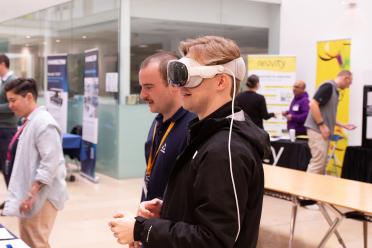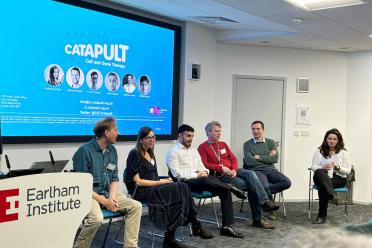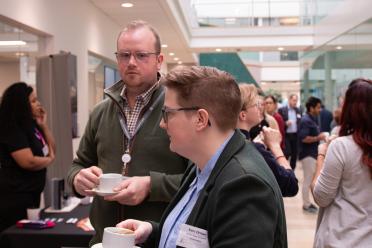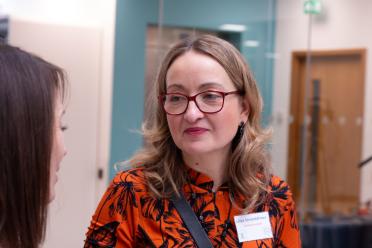Stronger together: partnerships take centre stage at EI Innovate
Collaborations were in the spotlight at this year’s EI Innovate, with a focus on the Earlham Institute’s cutting-edge work with external partners.
The Earlham Institute welcomed more than 80 delegates to the fifth edition of its annual event designed to foster conversation between academia and industry.
Technology development, knowledge exchange, transferring skills, and innovation were all featured in this showcase of the exciting work the Institute is undertaking with collaborators from a range of sectors.

Tech company Automata demonstrate their lab automation equipment using VR devices
Dr Liliya Serazetdinova, the Institute’s Head of Business Development and Impact, said this year’s programme had been designed to illustrate the diverse ways of engaging with the Institute.
“We’d like to show how the Institute and its collaborators are driving cutting-edge research and technology development through partnerships,” she said.
“At the Earlham Institute, we aim to achieve impact from our research and expertise through collaborations and partnerships. Being heavily focused on technology development, we are helping other organisations to innovate while we develop our own innovative technologies and approaches.
"This year we were delighted to showcase many examples of what these partnerships and innovations could achieve.”
Each year the meeting attracts delegates from a range of sectors, including agri-food, life sciences, biotechnology, medical technology, and clinicians, as well as developers of instrumentation, tools, and services for genomics and bioinformatics.
The Earlham Institute has been collaborating with a wide range of technology companies to push the boundaries of sequencing technology and develop applications in a wide range of areas.
These include development of new products and services for the life science sector, biomanufacturing, crop improvement, and microbiome research.
Partnerships on show included projects with Agilent Technologies, Oxford Nanopore Technologies, and the Cell and Gene Therapy Catapult.
Dr Iain Macaulay, the Institute’s Technical Development group leader, joined Amie Hunter, Genomics Field Applications Scientist for Agilent Technologies, to discuss targeted long-read sequencing for single-cell transcriptomics.

Panel discussion during the Technology Development session
He said sequencing an entire transcriptome could be costly and would give the products of many genes not of interest, while technology to target genes would give a clearer picture of the gene being studied.
This could give a huge advantage for academic and industrial research in single cell applications, allowing researchers to focus on low abundant or rare cells. This could be vital in understanding important mechanisms in cell biology, how cells function, or how living systems develop and respond to disease.
And Nathan Bagby, research scientist, and Dr Mateusz Budnik, machine learning researcher, both from Oxford Nanopore Technologies, joined Dr Conrad Nieduszynski, Earlham Institute group leader, for a presentation on new techniques in base calling.
Mr Bagby said a number of insights had been gained through working with the Institute.
“We were able to get into the dark matter of the genome, looking at the clusters of replication origins around the centromeres,” he said.
“The detection possible with ONT sequencing allows study of replication dynamics at the single molecule level.”
Dr Nieduszynski added that applications of this technology were far reaching, from fundamental research into the mechanisms of DNA replication to very applied research such as understanding the development of genetic diseases.
The Institute recognises the significant benefit of knowledge exchange for both academia and industry. These conversations can not only solve complex problems, but also translate scientific discoveries into practical applications.
Knowledge exchange fosters new collaborations and partnerships while providing access to valuable resources - datasets, expertise, or equipment - that may be difficult to access otherwise.
Secondments and placements expose researchers to non-academic perspectives - giving them new insights into running projects, working with multidisciplinary teams and seeing the bigger picture.

Kate Orman and Alistair Wright from the British Beet Research Organisation (BBRO)
Delegates heard from Dr Alistair Wright and Dr Kate Orman of the British Beet Research Organisation, who have been working with the Institute’s Hall Group on decoding the variability of Cercospora leaf spot.
“We worked with the Earlham Institute to optimise our methodology and produce proof of concept,” said Dr Wright. “The amplicon sequencing work with the Institute is really going to benefit us.”
Dr Daniel Olvera of the Institute and PhD student Sarah Bailey from the John Innes Centre have used the Institute’s Grassroots genomics platform to support their phenotyping work as part of the Delivering Sustainable Wheat (DSW) programme. They focused on reducing error when logging phenotypical variation in wheat.
And Yash Bancil, third-year PhD student at the institute, described his CASE Studentship with Cambridge-based Microbiotica - a biopharmaceutical company specialising in developing precision-based medicine though live biotherapeutic products.
He is developing new single-cell-based methodologies for characterising complex microbiomes. This could yield new insights and ways to treat patients.
Skills development and knowledge transfer does not just apply to experienced researchers.
Earlham Institute has signed the Technicians Commitment and supports exchange and development for technical staff. The institute also fosters skills development in PhD students, by supporting student placements and industrially supported CASE studentships.

“At the Earlham Institute, we aim to achieve impact from our research and expertise through collaborations and partnerships. Being heavily focused on technology development, we are helping other organisations to innovate while we develop our own innovative technologies and approaches.

Dr Liliya Serazetdinova, Head of Business Development and Impact, Earlham Institute
The Institute’s Innovation showcase featured talks on innovations that we support as well as our own innovations.
Delegates heard from Ben Williams, chief technology officer at Sun Bear Biofuture - a company developing synthetic, sustainable alternatives to widely used fats like palm oil and cocoa butter.
The demand for these products mean environmental impact for the countries of origin, and rising costs as industry is working to reduce impacts.
Access to alternative, more environmentally friendly, and cost effective plant-derived fats will benefit consumers, growers, and land owners.
Ben shared his experience of Sun Bear Biofuture working with the Earlham Biofoundry to test and scale up their products.
Harry Rousham, head of science commercialisation and IP at the Natural History Museum, described a joint venture between the museum and the Institute. The commercialisation of AirSeq builds on collaborative technology development over the last 13 years.
AirSeq is a system that can combine air capture with near-real-time sequencing and analysis to provide early warning of airborne pathogens.
“We have been trialling AirSeq in industrial settings - this technology can identify exactly what pathogens are in the air, detecting very small quantities, within three hours,” he explained.
“There are many possible applications, in the agriculture, civil, and defence sectors. One of the challenges is that applications of this technology are very broad.”
“We have been working very closely with the Institute's Business Development and Impact team to move the technology from the lab to industry.”

Dr Liliya Serazetdinova, Head of Business Development and Impact at the Earlham Institute.
As part of the EI Innovate programme, the Institute hosted leading providers of technologies and genomics innovation as exhibitors in the EI Innovate Exhibition Zone – Automata, Opentrons, Oxford Nanopore, PacBio, Hamilton, and Revvity joined the event.
There was also an opportunity for delegates to tour our state of the art platforms - High-Performance Sequencing, Single Cell and Spatial Analysis, and the Earlham Biofoundry.
For further information on how to collaborate with Earlham, please contact the Business Development and Impact team.